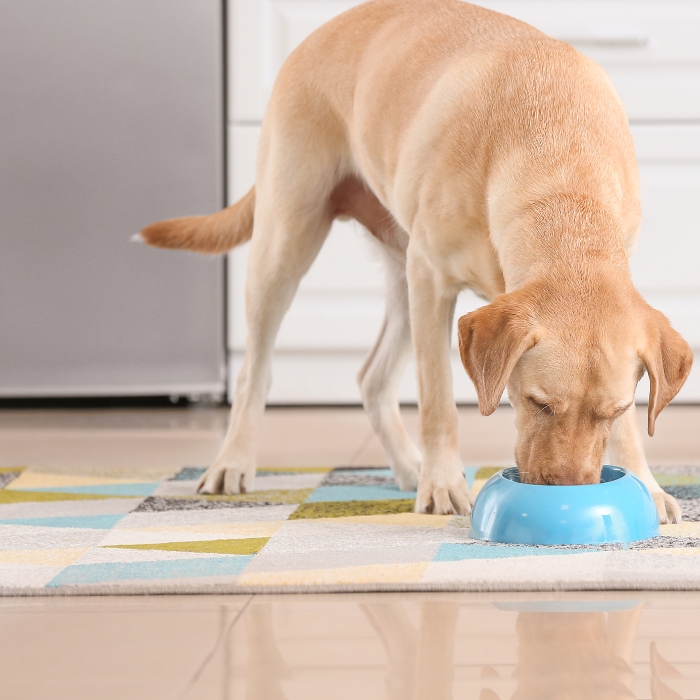
Top Causes of Allergic Itching in Dogs and How to Stop It
Skin problems are among the most common health complaints in dogs. Itching, redness, rashes, hair loss and pus-filled skin lesions can be caused by a variety of factors, some of which are allergy-related, while others stem from infections or external parasites. It is the owner's responsibility to recognise the symptoms, understand the causes and take the necessary steps to ensure their dog's health. Read on to learn about the most common triggers of allergic skin problems in dogs and how to prevent or treat them!
What factors can trigger skin symptoms in dogs?
1. Food Allergy
It is becoming increasingly common for dogs to have an allergic reaction to certain food ingredients — such as chicken, beef, dairy products, eggs, wheat, or corn. Most commercially available dog foods contain basic ingredients such as chicken, wheat and corn, repeatedly exposing dogs’ immune systems to these allergens. This continuous exposure raises the risk of developing food sensitivities. Symptoms can include itching, ear infections, digestive issues and chronic diarrhoea, all of which can significantly impact the animal's well-being and quality of life.
2. Environmental allergens (atopy):
Pollens, moulds, dust mites and human skin flakes can all trigger allergic reactions. Atopic dermatitis (eczema) often appears seasonally, but may eventually persist year-round. Dogs typically scratch their paws, belly, face and ears. Chronic itching may lead to skin damage, infections, and increased discomfort. Early identification and management of the allergen source are key to reducing flare-ups and improving quality of life.
3. Flea Allergy
The allergic reaction to flea bites is not caused by the fleas themselves, but by the proteins in their saliva. A sensitive dog can experience severe skin symptoms from even a single flea bite. Common signs include intense itching, hair loss, and red, inflamed skin, particularly around the base of the tail and hindquarters. Consistent flea prevention is essential to avoid flare-ups and secondary skin infections.
4. Chemicals and Cleaning Products
Some household cleaners, detergents, floor cleaners, sprays and shampoos can irritate a dog's skin. While these are not true allergies, they can cause irritant contact dermatitis. Common household allergens include scented laundry detergents, fabric softeners, air fresheners, disinfectant sprays, bleach and ammonia-based cleaners. Even some essential oils, such as tea tree and eucalyptus, can be problematic. Affected areas may become red, itchy or scaly, particularly where the skin has come into direct contact with the substance. Using fragrance-free, pet-safe products can help minimise the risk of irritation.
5. Stress and Psychological Factors
It arises when psychological distress triggers a compulsive grooming response, releasing endorphins that temporarily soothe the dog but ultimately worsen skin damage. It is crucial to identify and address the underlying emotional triggers for effective management.

6. Infections and Parasite-Related Skin Diseases
- Pyoderma: A bacterial skin infection often accompanied by pus-filled blisters (pustules), open sores and hair loss. It is one of the most common skin diseases in dogs.
- Dermatophytosis (fungal infection): An infection affecting the keratinised tissues of the hair, skin and claws, caused by fungi such as Epidermophyton, Microsporum and Trichophyton. Often called 'tinea', it may present as circular hair loss and scaling.
- Malassezia infection (yeast fungus): Malassezia is a yeast that is commonly found on the skin of nearly all dogs. Overgrowth of this fungus can cause greasy, foul-smelling dermatitis (seborrhoea), external ear infections (otitis externa), eyelid inflammation (blepharitis) and inflammation of the nail bed (paronychia).
- Mange (demodicosis): Mange is caused by an overgrowth of Demodex mites. These mites are normally present on the skin, but if they proliferate excessively due to a weakened immune system or genetic predisposition, they can cause dermatitis, patchy hair loss and severe skin damage.
What Can Owners Do to Eliminate the Causes?
1. Food Change and Elimination Diet
If a food allergy is suspected, an elimination diet is the best method. This involves feeding your dog a single new protein source (e.g. rabbit, duck or salmon) and a single new carbohydrate source (e.g. sweet potato) for 8–12 weeks. If symptoms improve, a food allergy is likely. Then, suspected ingredients can be reintroduced one by one to observe the dog's reaction to each one.

2. Regular Coat and Skin Care
Regular skincare is key to preventing and alleviating allergic skin symptoms. This includes bathing with hypoallergenic shampoo, which gently cleanses the skin while reducing the risk of irritation. Washing your pet's paws thoroughly after walks helps to remove environmental allergens, while regular grooming prevents matting and supports skin health.
3. Reducing Environmental Allergens
Environmental allergens, such as pollen, dust mites and mould, play a significant role in causing allergic skin symptoms in dogs. To minimise their impact, vacuum frequently, especially in areas where the dog spends time. Using air purifiers with HEPA filters can help remove fine airborne allergens, improving respiratory and skin comfort. Also, provide your dog with a well-ventilated bed that is regularly washed with a hypoallergenic, fragrance-free detergent to minimise allergen build-up.
4. Flea Control
Regular flea prevention is crucial since even a single flea bite can cause severe allergic reactions in sensitive dogs. Spot-on treatments, collars, and oral tablets effectively kill fleas and prevent reinfestation.
5. Use Gentle Cleaning Products
Use natural, chemical-free cleaners for floors and washing the dog's bedding. Avoid scented products and alcohol-based disinfectants.
6. Addressing Psychological Causes
Maintaining the dog's mental health is important. Ensure daily exercise, play, and mental stimulation. For persistent stress, behavioural therapist or veterinarian assistance may be necessary. Providing a stable routine, safe environment, and positive human interaction can significantly reduce anxiety. In some cases, calming supplements or medications may also be recommended as part of a comprehensive treatment plan.

Natural Support for Skin Problems
Natural, herbal remedies are gaining attention as a way of treating dogs' skin diseases, helping to reduce reliance on medication and its side effects. Charmaid is an oral capsule containing herbs and minerals that has been specifically developed to treat various skin problems in dogs, such as mange, impetigo, eczema, fungal infections, dermatitis, skin injuries and allergy-related symptoms.
Charmaid works by strengthening the immune system and reducing inflammation to aid skin regeneration and relieve unpleasant symptoms such as itching, redness and irritation.
Main active ingredients:
- Azadirachta indica — strong antimicrobial effect
- Cedrus deodara — anti-inflammatory and immune-modulating
- Curcuma longa (turmeric) — antioxidant and wound-healing
Benefits of use:
- Reduces inflammation, itching, and irritation.
- Strengthens the immune system and supports wound healing.
- Antimicrobial, antiparasitic, and antifungal effects.
- Suitable for prevention and aftercare.
- Helps prevent symptom recurrence.
Regular use of Charmaid can effectively complement the treatment of allergic and infectious skin problems in dogs, improving their quality of life.
If you notice any unusual skin symptoms on your dog, consult a vet immediately — the skin is the body's first line of defence and always signals when something is wrong!
